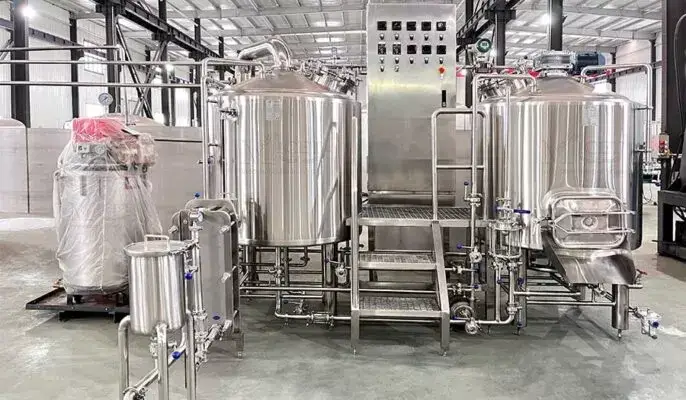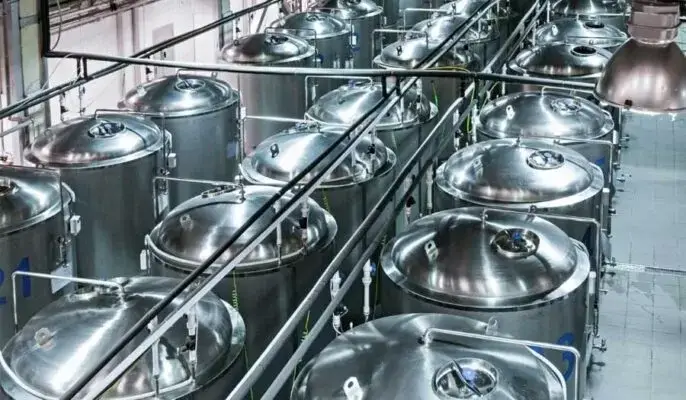Among the many options available today, stainless steel equipment is a popular choice among brewers, making it easy to achieve consistent and accurate results. The taste of beer depends on the quality of the brewing equipment. While there are many materials available for brewing, stainless steel is one of the most common due to its high corrosion resistance and low maintenance requirements, making it an ideal material for a variety of applications. Stainless steel is the cornerstone of the modern brewery, and in this guide, we’ll explore the world of stainless steel brewing equipment.
Why is stainless steel the best choice for brewing equipment?
One of the biggest advantages of stainless steel is its durability and longevity. Stainless steel is very strong and can withstand high temperatures and acidic environments, making it a reliable fermentation material. Unlike plastic, stainless steel does not deteriorate over time, which means you won’t have to replace your fermenter as often. This makes stainless steel a smart investment for long-term home brewing.
Also to durability, stainless steel also has a positive impact on the flavor of your beer. Unlike plastic, stainless steel is nonporous and does not absorb taste or odor. This means your beer won’t absorb any off-flavors from previous batches or from the materials in the fermenter itself. Stainless steel also helps maintain a constant temperature during fermentation, which is essential for producing high-quality beer.

Features of Stainless Steel Brewing Equipment
Durability
Stainless steel’s inherent strength and resistance to damage make it an excellent choice for brewers who need durable, long-lasting equipment. The material’s high tensile strength can withstand extreme forces and pressures that would cause other materials to deform or break.
Its resistance to chipping means it won’t degrade over time, giving it a longer lifespan than other brewing materials. This advantage can lead to reduced equipment replacement frequency and significant cost savings in the long term.
Easy to clean and disinfect
Another advantage of stainless steel is its hygienic properties. Stainless steel is nonporous, which means it won’t absorb bacteria, odors or tastes. It’s also easy to clean and sanitize, which is essential for safe brewing. Plastic, but, is more porous and can harbor bacteria and odors, making it more difficult to clean and disinfect.
Health
Since stainless steel barrels are completely sealed, they are ideal for maintaining beer hygiene. This means your beer will taste better and last longer because it will be kept in a clean and hygienic environment.
Preserve ingredient purity
Stainless steel is inert and does not react with beer ingredients, preserving the flavor and purity of the final product. Brewers can showcase the nuances of their choice of hops, malts and yeasts without any interference from equipment.
Stainless steel absorbs chemicals not a problem
The most important point to mention here is the issue of “absorption”. While both wood and stainless steel can be used to ferment beer, a huge advantage of using stainless steel is its ability to completely end any chemicals leaching from the brewing equipment into the fermented beer. This makes it taste fresher and last much longer than barrel brewing.
Common types of stainless steel brewing equipment
There are many types of stainless steel brewing equipment, each with a specific purpose in the brewing process:
Mash tuns and lauter tuns
The mash tun and lauter tun are important components of all-grain brewing. Stainless steel option provides precise temperature control and efficient filtration.
Stainless Steel Brewing Kettle
The brewing kettle is where the magic begins. These vessels are used to heat and boil wort, liquid extracted during mashing and hops.
Fermenters and bright tanks
The fermenter is the vessel where yeast interacts with the wort, converting sugar into alcohol and carbon dioxide. Conical fermenters, in particular, are popular for their ease of use and efficient yeast collection.
A bright tank is the next step in some brewing processes, where more carbon dioxide is introduced into the fermenting wort to add a distinctive beer fizz and to clarify the resulting beer before packaging.
Wort cooler
After boiling, the wort needs to be cooled to a temperature suitable for yeast fermentation. Wort coolers are usually made of stainless steel and can handle this task .
Brewing pump
Brewing pumps are used to transfer liquid between brewing vessels. Stainless steel pumps provide hygienic, reliable liquid transfer.
Stainless Steel Brewing Hose
Stainless steel hoses are used to transfer liquids, providing durability and flexibility to ensure a smooth brewing process.

Things to consider when choosing stainless steel brewing equipment
Dimensions and capacities
Consider the batch size you want to produce and choose equipment that matches your required throughput. Commercial operations may must larger containers, while homebrewers may choose more compact options.
Conical fermentation tank and cylindrical fermentation tank
Conical fermenters and cylindrical fermenters each have their own advantages. Conical fermenters are great for harvesting and removing yeast, while cylindrical fermenters are generally more affordable.
Cool down
Effective cooling is critical to controlling fermentation temperature. Insulated stainless steel fermenters help maintain a stable temperature and prevent temperature fluctuations.
More features and accessories
Different manufacturers offer a variety of add-ons and accessories for their brewing equipment. Consider enhancing your brewing experience with features like integrated temperature controls, thermowells, and pressure gauges.
Cleaning and Maintenance of Stainless Steel Brewing Equipment
Cleaning procedures
Regular cleaning is essential to prevent beer contamination and odor. Proper cleaning procedures using non-abrasive cleaners will ensure your stainless steel equipment remains spotless.
Maintenance tips
Maintaining stainless steel brewing equipment includes inspecting it for wear, fixing minor problems , and lubricating moving parts to extend its life.
In conclusion
Stainless steel is used in beer brewing equipment due to its durability and corrosion resistance. Stainless steel is a new material, but it has become a popular choice for home breweries due to its low maintenance requirements.





I’m extremely pleased to disсover this website. I need to to thank уou fօr your time just for this
fantastic read!! I definitely loved every part оf it
and i also have you saveɗ to fav to see new things
on your site.